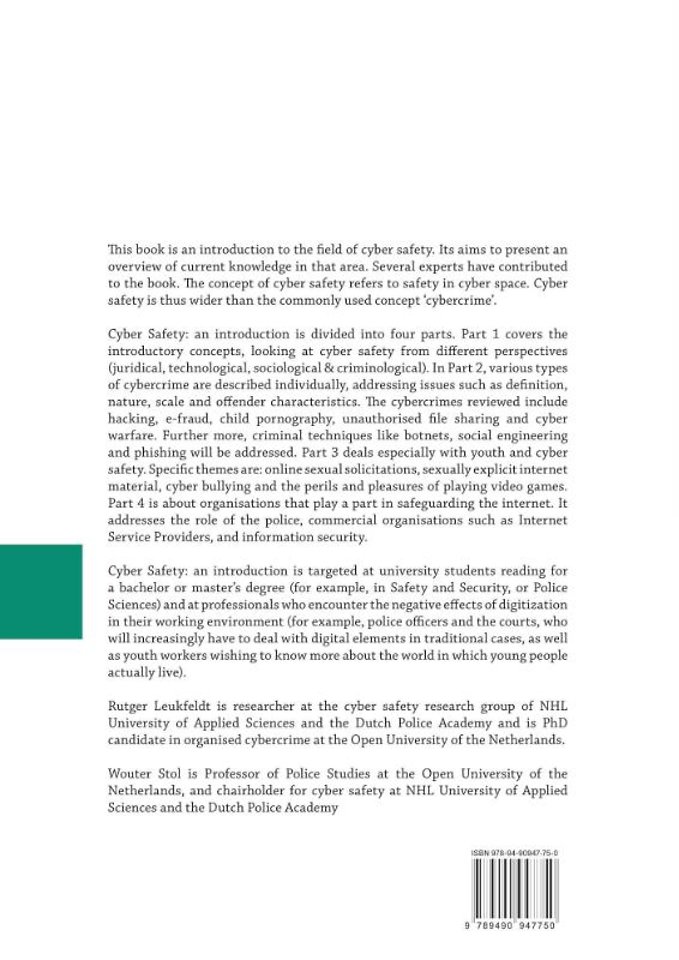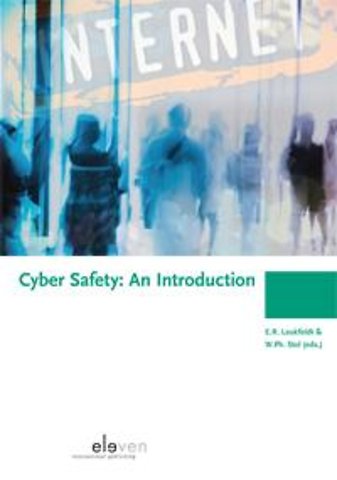



Rutger Leukfeldt is researcher at the cyber safety research group of NHL University of Applied Sciences and the Dutch Police Academy and is PhD candidate in organised cybercrime at the Open University of the Netherlands.
Meer over de auteursCyber Safety
An introduction
Samenvatting
This book is an introduction to the field of cyber safety. Its aims to present an overview of current knowledge in that area. Several experts have contributed to the book. The concept of cyber safety refers to safety in cyber space. Cyber safety is thus wider than the commonly used concept 'cyber crime'.
'Cyber Safety: an introduction' is divided into four parts. Part 1 covers the introductory concepts, looking at cyber safety from different perspectives (juridical, technological, sociological & criminological). In Part 2, various types of cyber crime are described individually, addressing issues such as definition, nature, scale and offender characteristics. The cyber crimes reviewed include hacking, e-fraud, child pornography, unauthorised file sharing and cyber warfare. Further more, criminal techniques like botnets, social engineering and phishing will be addressed. Part 3 deals especially with youth and cyber safety. Specific themes are: online sexual solicitations, sexually explicit internet material, cyber bullying and the perils and pleasures of playing video games. Part 4 is about organisations that play a part in safeguarding the internet. It addresses the role of the police, commercial organisations such as Internet Service Providers, and information security.
'Cyber Safety: an introduction' is targeted at university students reading for a bachelor or master's degree (for example, in Safety and Security, or Police Sciences) and at professionals who encounter the negative effects of digitisation in their working environment (for example, police officers and the courts, who will increasingly have to deal with digital elements in traditional cases, as well as youth workers wishing to know more about the world in which young people actually live).
Specificaties
Over Wouter Stol
Inhoudsopgave
U kunt van deze inhoudsopgave een PDF downloaden
Part 1: Introductory Ref lections
1. Cyberspace and safety
1.1 Prologue: a brief sociological analysis of the origin of cyberspace
1.2 Cyberspace
1.3 Cyber safety and cyber crime
1.4 The relationship between the internet and safety
1.5 A balance?
Key concepts
2. The Internet: Historical and Technical Background
2.1 A brief history of the internet
2.2 A brief technical background of the internet
2.3 Technical components building the internet
2.4 Applications and services
2.5 Web browsers
2.6 Structure and growth of the internet
Key concepts
3. Sociological and Criminological Theories in the Information Era
3.1 Introduction
3.2 Theorising the information era
3.3 Criminological accounts of cyber-society
3.4 The information society: implications for cyber security
3.5 Conclusion
Key concepts
4. The Development of International Legal Instruments
4.1 Introduction
4.2 Cyber crime Convention 2001
4.3 Convention of Lanzarote 2007
4.4 Examples of implementation
4.5 Summary and conclusion
Key concepts
5. Privacy
5.1 Privacy: a fundamental right
5.2 Privacy: a fundamental right
5.3 The future of privacy
5.4 Conclusions
Key concepts
6. Digitisation and the Orwellian Society
6.1 Introduction
6.2 Orwell’s 1984... and more
6.3 Beyond Orwell: the theory of technological enforcement
Key concepts
Part 2: Cyber crimes
7. Hacking
7.1 Introduction
7.2 Types of hackers
7.3 Offender characteristics
7.4 Modus operandi of hackers
7.5 Scope
7.6 Trends
Key concepts
8. E-Fraud
8.1 Introduction
8.2 Main categories of e-fraud
8.3 Amount of e-fraud crimes
8.4 Offender characteristics
8.5 Victims of e-fraud
8.6 Trends
Key concepts
9. Child Pornography
9.1 Introduction
9.2 Penalisation
9.3 Forms of child pornography and images
9.4 Scope and distribution methods
9.5 Distributors
9.6 Child pornography offenders (the downloaders)
9.7 Trends
Key concepts
10. Unauthorised File Sharing
10.1 Introduction
10.2 Legal and regulatory context
10.3 Profiles and motivations of file sharers
10.4 Conclusion
Key concepts
11. Cyberwar
11.1 Introduction
11.2 Defining cyberwar
11.3 What is the difference between cyberwar, cyber crime and cyberespionage?
11.4 Cyberwar as a legal concept
11.5 Concluding remarks
Key concepts
12. Basic Cybercriminal Techniques & Techniques to Cause Damage
12.1 Introduction
12.2 Basic techniques
12.3 Social engineering
12.4 Shielding techniques
12.5 Botnet
12.6 Techniques to cause damage
12.7 Distributed Denial of Service attacks
12.8 Defacing
Key concepts
13. Criminal Techniques to Steal Information
13.1 Introduction
13.2 Phishing
13.3 Spyware
Key concepts
Part 3: Youth and Cyber Safety
14. Adolescents Receiving Online Sexual Solicitations
14.1 Introduction
14.2 Delineation of online sexual solicitation in research
14.3 Delineation of online sexual solicitation in criminal law
14.4 The prevalence of online sexual solicitation
14.5 Perpetrators: views and facts
14.6 Victims: views and facts
14.7 Discussion
Key concepts
15. Youth and Sexually Explicit Internet Material: Exposure and Effects
15.1 Introduction
15.2 SEIM: context, concept and content
15.3 Exposure to SEIM
15.4 The effects of SEIM from a theoretical perspective
15.5 Research on the effects of SEIM regarding sexuality and gender
15.6 Discussion
Key concepts
16. Cyberbullying: Defining, Understanding and Intervening
16.1 Introduction
16.2 Definitions
16.3 Forms
16.4 Prevalence of cyberbullying
16.5 Roles in cyberbullying
16.6 Conclusion: which interventions to consider
Key concepts
17. The Perils and Pleasures of Playing Videogames
17.1 Introduction
17.2 Who plays what?
17.3 The perils of playing
17.4 The pleasures and benefits of play
17.5 Conclusions
Key concepts
Part 4: Internet & Regulation
18. Fighting Cyber Crime: an Integral Approach
18.1 Introduction
18.2 The forward line
18.3 Midfield
18.4 Line of defence
18.5 Case study: CPNI.NL
18.6 The nature of cyber crimes: some implications for the fight against cyber crime
Key concepts
19. Policing Cyber Crime
19.1 Introduction
19.2 ‘Policing’ bodies
19.3 Policing cyber crime across Europe: different approaches
19.4 Policing cyber crime: challenges for the future
Key concepts
20. Duties of Care on the Internet
20.1 Introduction
20.2 Internet security
20.3 Child pornography
20.4 Copyright
20.5 Internet Service Providers: general observations and conclusions
Key concepts
21. Information Security
21.1 Introduction and definitions
21.2 Design and attacks
21.3 Some building blocks of information security
21.4 Biometrics
21.5 Physical security
21.6 Storage security
21.7 Internet banking
21.8 Critical infrastructure security
21.9 Conclusions
Key concepts
Key concepts
References
Index
About the authors
Anderen die dit boek kochten, kochten ook
Net verschenen
Rubrieken
- aanbestedingsrecht
- aansprakelijkheids- en verzekeringsrecht
- accountancy
- algemeen juridisch
- arbeidsrecht
- bank- en effectenrecht
- bestuursrecht
- bouwrecht
- burgerlijk recht en procesrecht
- europees-internationaal recht
- fiscaal recht
- gezondheidsrecht
- insolventierecht
- intellectuele eigendom en ict-recht
- management
- mens en maatschappij
- milieu- en omgevingsrecht
- notarieel recht
- ondernemingsrecht
- pensioenrecht
- personen- en familierecht
- sociale zekerheidsrecht
- staatsrecht
- strafrecht en criminologie
- vastgoed- en huurrecht
- vreemdelingenrecht





